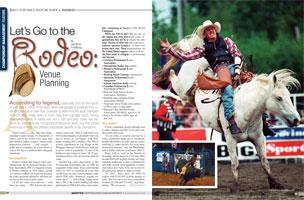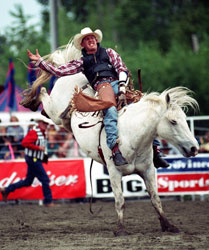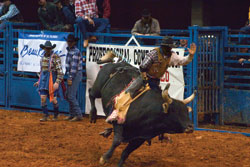
According to legend, rodeo was born on the Fourth of July. July 4, 1869, to be exact, when two groups of cowboys from local ranches met in Deer Trail, Colorado to determine the local champion of ranch skills.
Today, rodeo is much more than a grudge match among local ranch hands. In nearly one and a half centuries, rodeo had become an internationally recognized professional sport, one that draws enormous crowds and delivers impressive payoffs to its champions.
There's more to rodeo than just championship events, though. At thousands of rodeos across the world every year,fans and families gather round to watch some impressive cowboy - and cowgirl - skills and to celebrate, for a few hours or even a few days, a tradition that's uniquely American.
Get Organized
Rodeo's oldest and largest rodeo governing body, the Professional Rodeo Cowboys Association (PRCA), began at a rodeo at Boston Gardens in 1936 when a group of cowboys walked out in protest because the rodeo promoter refused to add their entry fees to the rodeo's prize purse.
 Of all the rodeo associations - and there are many - PRCA hosts the most rodeos each year. PRCA sanctions over 600 events annually, from small town venues to arenas in Las Vegas, with 2007 prizes totaling $40.5 million. The PRCA season culminates in Las Vegas at the Wrangler National Finals Rodeo. And just to prove rodeo's popularity, it's one of the hardest-to-get tickets in town: all 10 performances have sold out for more than 20 years.
Of all the rodeo associations - and there are many - PRCA hosts the most rodeos each year. PRCA sanctions over 600 events annually, from small town venues to arenas in Las Vegas, with 2007 prizes totaling $40.5 million. The PRCA season culminates in Las Vegas at the Wrangler National Finals Rodeo. And just to prove rodeo's popularity, it's one of the hardest-to-get tickets in town: all 10 performances have sold out for more than 20 years.
Another key rodeo association is The Professional Bull Riders, Inc., or PBR. Its organizers broke away from conventional rodeo in 1992 to establish an event that would focus on rodeo's most popular event, which PBR calls "America's original extreme sport" - bull riding. Today, more than 1,200 of the world's leading bull riders participate in PBR's 300-plus events annually, competing to become PBR World Champion.
While the PRCA and PBR are two of the largest and most prominent rodeo organizations, they are by no means the only ones. Dozens of other national rodeo associations sanction hundreds of their own events each year.These organizations (in the United States) support rodeos of all levels, from youth to collegiate to professional and beyond:
Cowboys Professional Rodeo Association
International Rodeo Association
Women's Professional Rodeo Association
Working Ranch Cowboys Association
American Professional Rodeo Association
African American Rodeo Group
Canadian Professional Rodeo Association (CPRA)
National High School Rodeo Association (NHSRA)
National Intercollegiate Rodeo Association (NIRA)
American Junior Rodeo Association (AJRA), ages 19 and under
National Little Britches Rodeo Association (NLBRA), ages 8 to 18
Senior Pro Rodeo (SPR), ages 40 and over.
Why Rodeo?
If your community doesn't already host a rodeo, chances are that if you start one, the people will come.
"Every rodeo is created and run by a rodeo committee made up of volunteers, people who believe in rodeo and see its potential to make money for local businesses and charities," says Jim Bainbridge, senior public relations coordinator,PRCA.
Many rodeos, such as the Pendleton Roundup, which started in 1910 and offers around $400,000 in prize money, are long-standing traditions in their communities and draw crowds from hundreds of miles. But rodeos don't have to be old or even offer giant prize purses to draw a crowd.
 "In 2007, there were 80 [PRCA] rodeos with $100,000 in prize money or more, but five out of six were somewhere between $5,000 and $10,000," says Bainbridge. "We cut across the full spectrum of pro rodeo. Some are rodeos where people are just starting in the sport, getting experience and working their way up."
"In 2007, there were 80 [PRCA] rodeos with $100,000 in prize money or more, but five out of six were somewhere between $5,000 and $10,000," says Bainbridge. "We cut across the full spectrum of pro rodeo. Some are rodeos where people are just starting in the sport, getting experience and working their way up."
It might seem that a community would need a western heritage or at least a rural atmosphere to make a good home for a rodeo, but rodeo's growing popularity proves that that's simply not true. Rodeos can be successful pretty much anywhere. It just takes some knowledge, some planning, and like every day on a ranch, a heaping portion of hard work.
The Rodeo Experience
For its first several decades, rodeos were completely independent, choosing their own unique blend of events from the hundreds of cowboy skill-testing contests, such as calf roping, steer roping, team roping, steer wrestling, barrel racing. But today's rodeos involve standardized sets of events, dictated by the association sanctioning each event.
Many of today's rodeos also involve much more than just cowboys, livestock and horses. These state fair-type events offer an entire day - or several days - of food, rides, games and entertainment capped off each evening by the main event, the actual rodeo.
Organizers promote the Cheyenne Frontier Days in Cheyenne, Wyoming , as the world's largest outdoor rodeo and western celebration. The event is also the nine-time and reigning PRCA Large Outdoor Rodeo of the Year. Held during the last full week in July, one of rodeo's busiest months, Cheyenne Frontier Days is a 10-day extravaganza of rodeo, concerts and western history.
With a total purse of more than $1,000,000, the San Antonio Stock Show & Rodeo brought together in 2007a combined 30,000 entries from 32 states and more than 1.2 million visitors from all 50 states and 41 foreign countries. And rodeo attendance is about more than just ticket sales. In 2007, the San Antonio Stock Show & Rodeo sold nearly 33,000 sodas, 20,000 hot dogs and nearly 5,000 pounds of brisket, a Texas specialty.
But bigger isn't necessarily better and successful rodeos don't have to be such mammoth affairs. Locations interested in bringing a rodeo to town might take a look at one of the country's smaller community rodeos as an example.
Beaumont, Texas, hosts not only two rodeo events, but also a PBR bull riding event and several livestock shows each year in their Ford Park arena. But Beaumont also has another key asset that makes its rodeo events successful: manpower.
"We're lucky we have a local association, the Young Men's Business League (YMBL) a local nonprofit that has the manpower to put on these kinds of events," says Rebecca Woodland, convention sales manager at the Beaumont Convention and Visitors Bureau. "They host the rodeos and PBR events, work with the promoters to put them on, and they give the money they raise back into the community in charitable funds."
Willard also explains how rodeos bring a boost to more than just charitable organizations in Beaumont. "In terms of tourism, it brings in lots of hotels rooms in addition to RVs. It infuses our economy with dollars from outside our area as well as being an attraction for our residents."
On the northwest side of Texas, nearly 700 miles away, is another town that brings together tourists and residents with regular rodeos.
"Lubbock is a prime location for rodeos," said Scott Harrison, sports manager for Visit Lubbock. "We are the hub of rodeo country."
Home to several rodeo-ready facilities including the Texas Tech Equestrian Center, the Fair Park Coliseum at the South Plains Fairgrounds and the City Bank Auditorium & Coliseum on the Texas Tech Campus, Lubbock hosts numerous rodeos each year, including the ABC Rodeo, Texas Tech Rodeo and the Lubbock Winter Rodeo.
Rodeo Rides Out of the West
Rodeo may be the official state sport of Texas and Wyoming, but it is also a sport with national appeal. Rodeos in the Southeast, Midwest and the Northeast are gaining popularity and attendance every year.
"I think the attraction is you get to see cowboys and cowgirls doing an assortment of different events from bull riding to barrel racing," says Scott Bruscato, conventions and sports marketing, Monroe-West Monroe Convention and Visitors Bureau. "But it also offers things for all ages, from arts and crafts to food… it's a pretty lively atmosphere."
Bruscato should know. Monroe and West Monroe, in northern Louisiana, have hosted quite a few rodeos over the years, including the Bayou Black Rodeo, an all African American event, the Louisiana Rodeo Association Rodeo and numerous livestock shows.
"We have the Ike Hamilton Expo Center, an all-dirt, enclosed, air-conditioned facility with 3,000 chair-back seats. It's got about 50,000 square feet of dirt arena, livestock pens and a horse barn with 510 stalls," says Bruscato. "It's a neat atmosphere for rodeos and a facility that really makes the event for us."
The Monroe Civic Center, where the Bayou Black Rodeo is held, offers another attractive, air-conditioned rodeo venue with seating for 5000. And in the Southeast, particularly in the summer, an air-conditioned facility can have tremendous crowd appeal.
Some rodeos don't even need air-conditioning, though. Every Saturday night, from July to Labor Day weekend, rodeo fans, and more than a few curious New Englanders, make their way across the green fields of Vermont to the Pond Hill Ranch Rodeo.
Pond Hill Ranch offers more than just a good show, though. The Pond Hill Ranch Pro Rodeo Company, in its 39th year of producing rodeos, helps communities build their own rodeos.
"A lot of organizations decide they might want to do a rodeo to make money or for a nonprofit," says Harry O'Rourke, owner of Pond Ranch. "They contact us, and we do everything, including bringing the arena fencing, that it takes to produce that rodeo."
A piece of the profits from many rodeos across America go to local nonprofits and charities, but one rodeo in Boston was conceived entirely as a means of support to critical charities.
"The Spirit of the American Cowboy Foundation got underway in2006," says Mike Allison, executive director and founder of the Spirit of the American Cowboy Foundation. "We had a more generic purpose in the beginning, to raise money to help charities start their own rodeos, but then we found out about a friend whose son's cancer had relapsed. When we found out, we decided that this was the purpose that led us to create the foundation, and it unified us around cancer research."
The Foundation's signature fund raising event is the New England Wild West Fest TM, a three-day festival and rodeo in Marshfield, Mass. Allison, a former professional rodeo athlete, and the rest of the Spirit of the American Cowboy team work on an entirely volunteer basis so that every dollar raised by the event can go directly to cancer research.
But just because it's a charity event, don't think that the New England Wild West Fest is anything less than a top-notch rodeo. With a $40,000 purse in 2007, the PRCA-sanctioned rodeo attracts serious professional athletes on the PRCA circuit.
Rope Your Own Rodeo
Rodeos can bring in the crowds and generate big bucks for both communities and charities. With the right venue - or a rodeo production company to help produce the event - any community can start putting together their own celebration of the Wild West today. Start with these steps to a great rodeo:
Put together your purse. The key to drawing a crowd is attracting great competitors, and prize money is a good start.
Get sanctioned. Rodeo athletes compete on a circuit, collecting points to move higher in the competition, so the best athletes will stick to their circuit.
Get an expert. Contact the rodeo association of your choice for guidance or consider hiring a rodeo expert like Mike Allison, who offers consulting services to benefit his charity.

